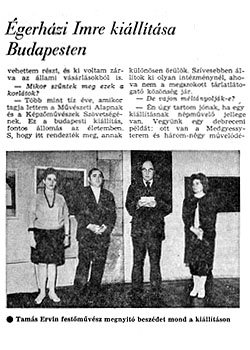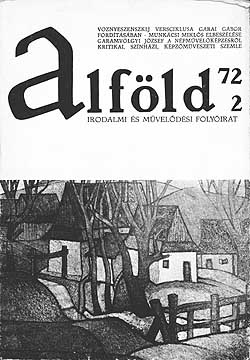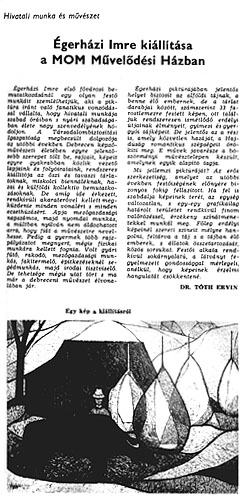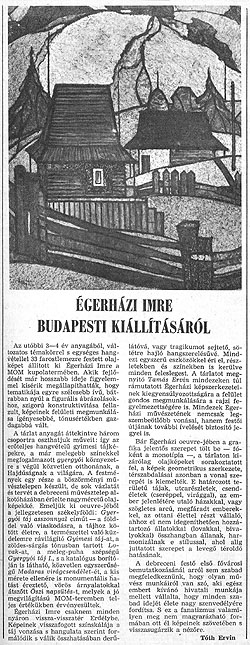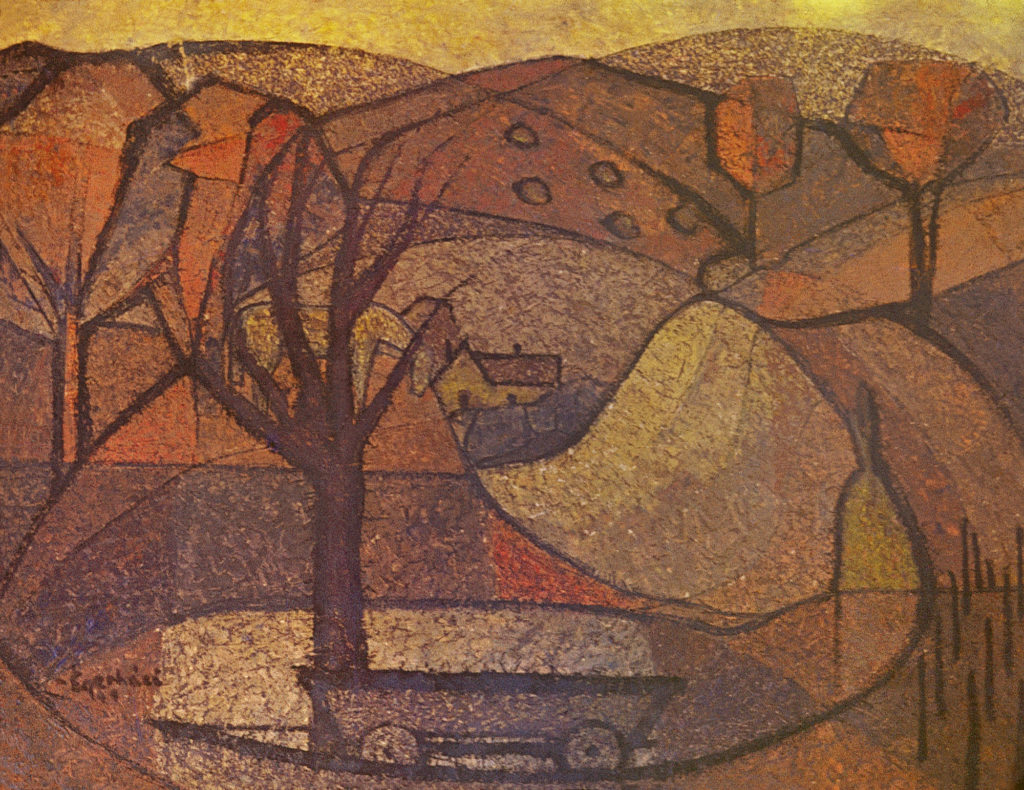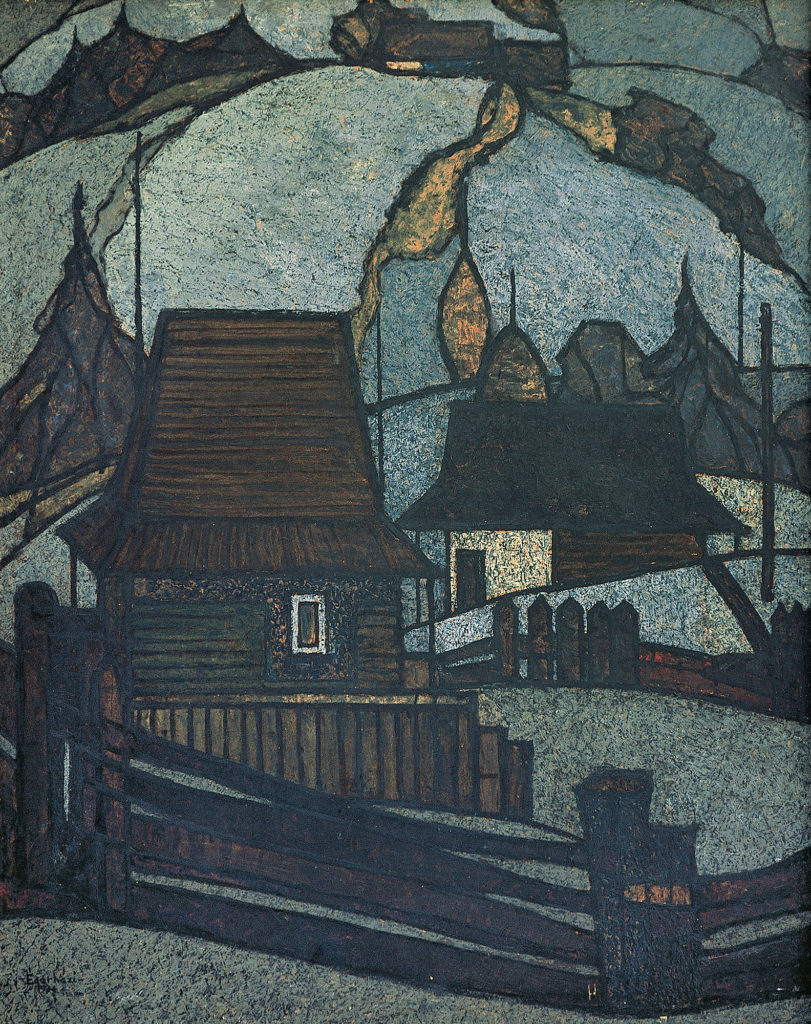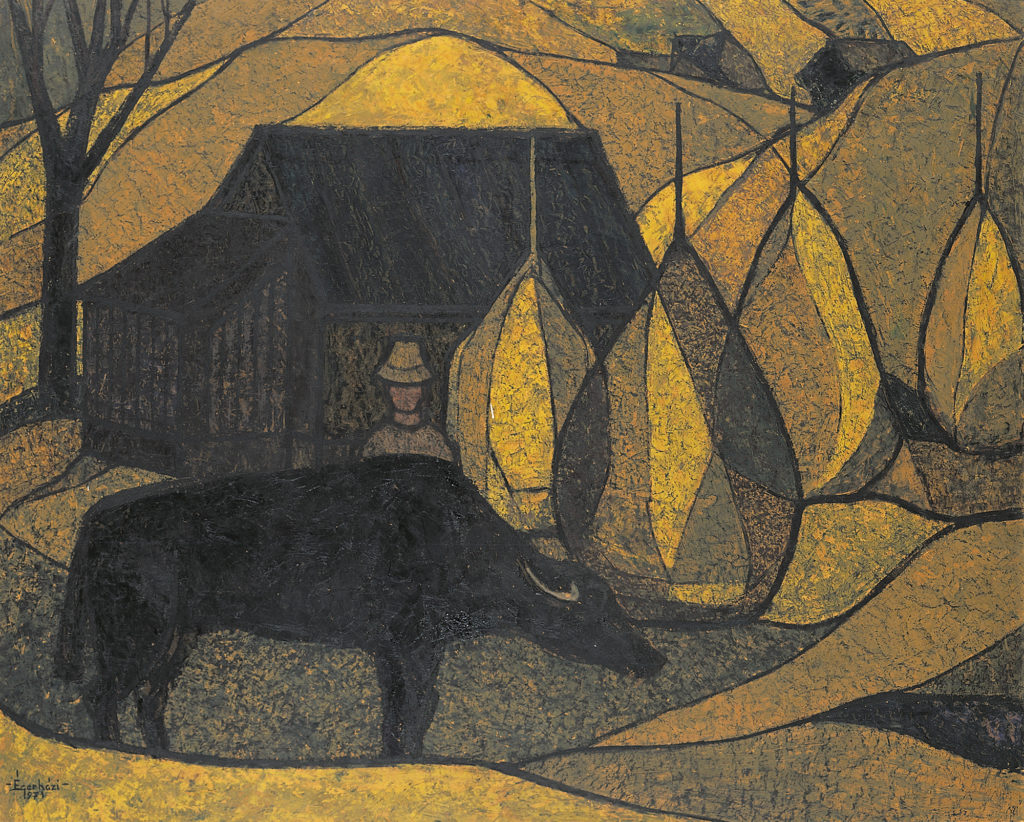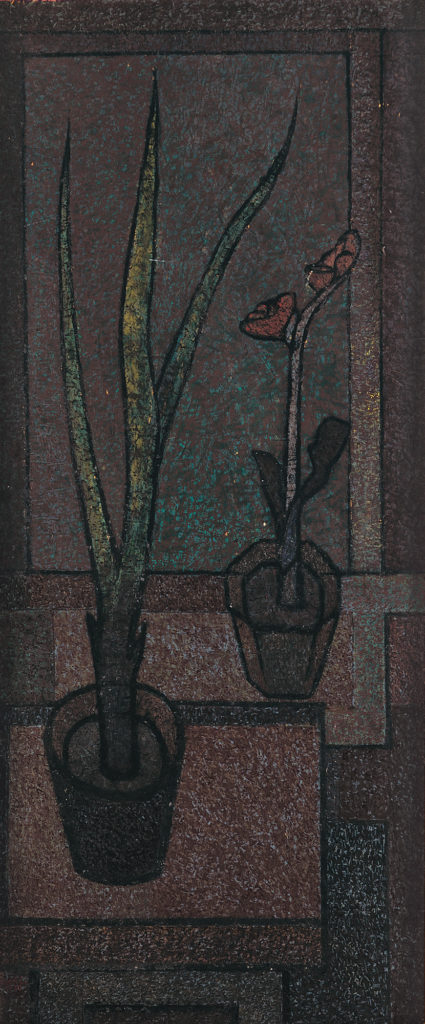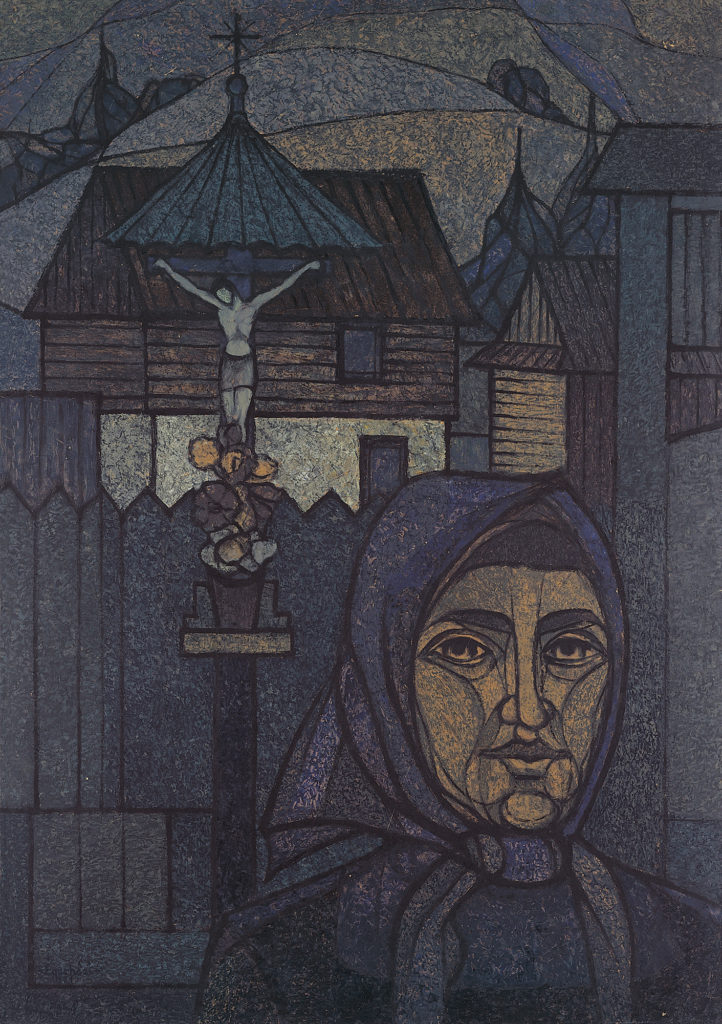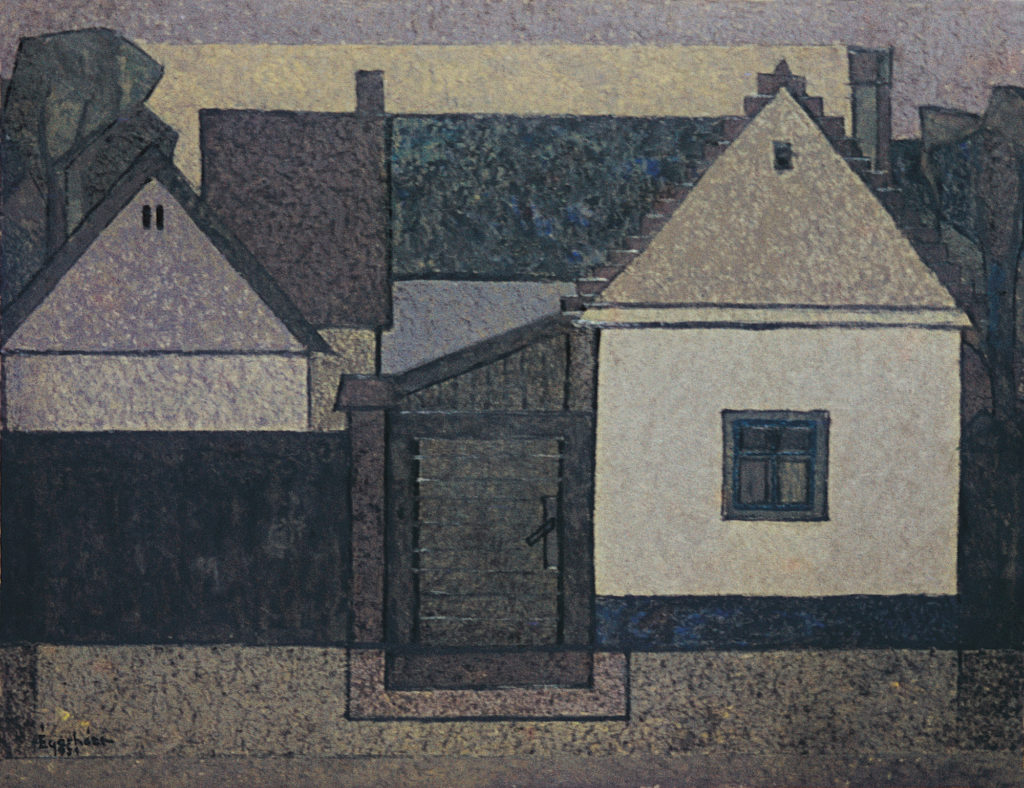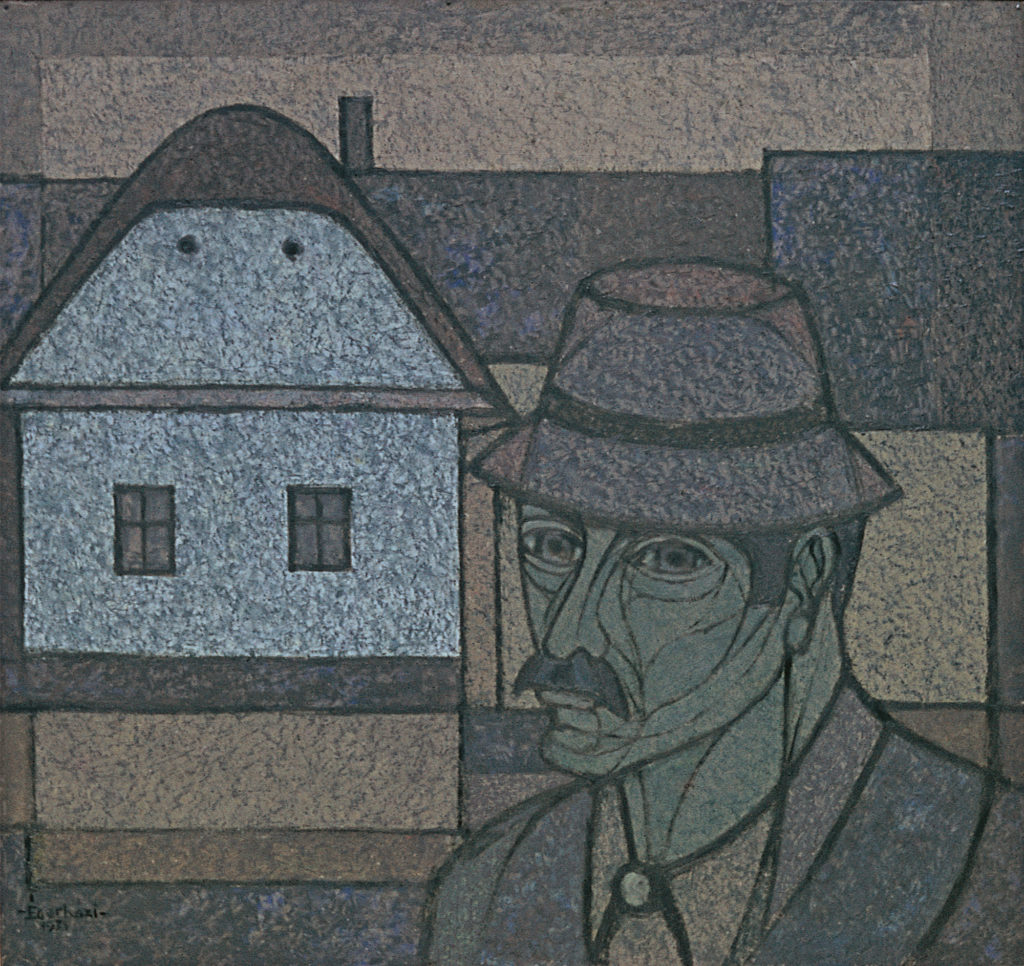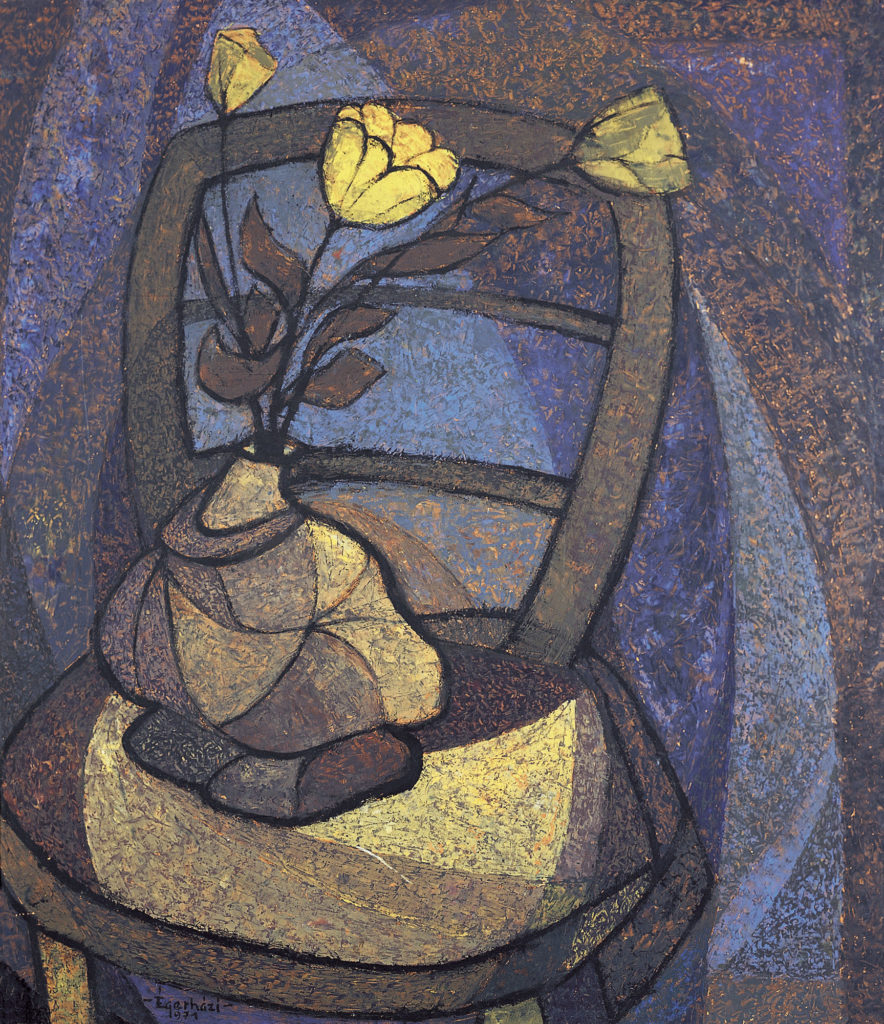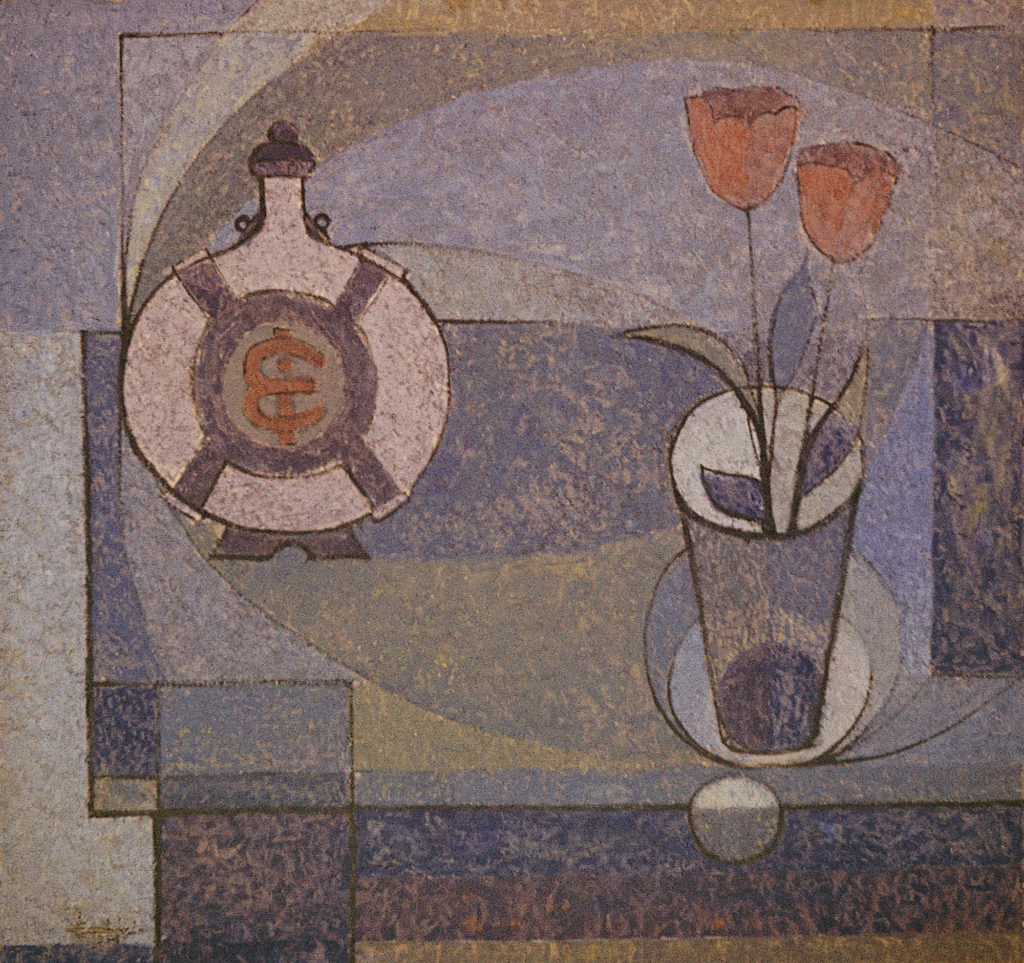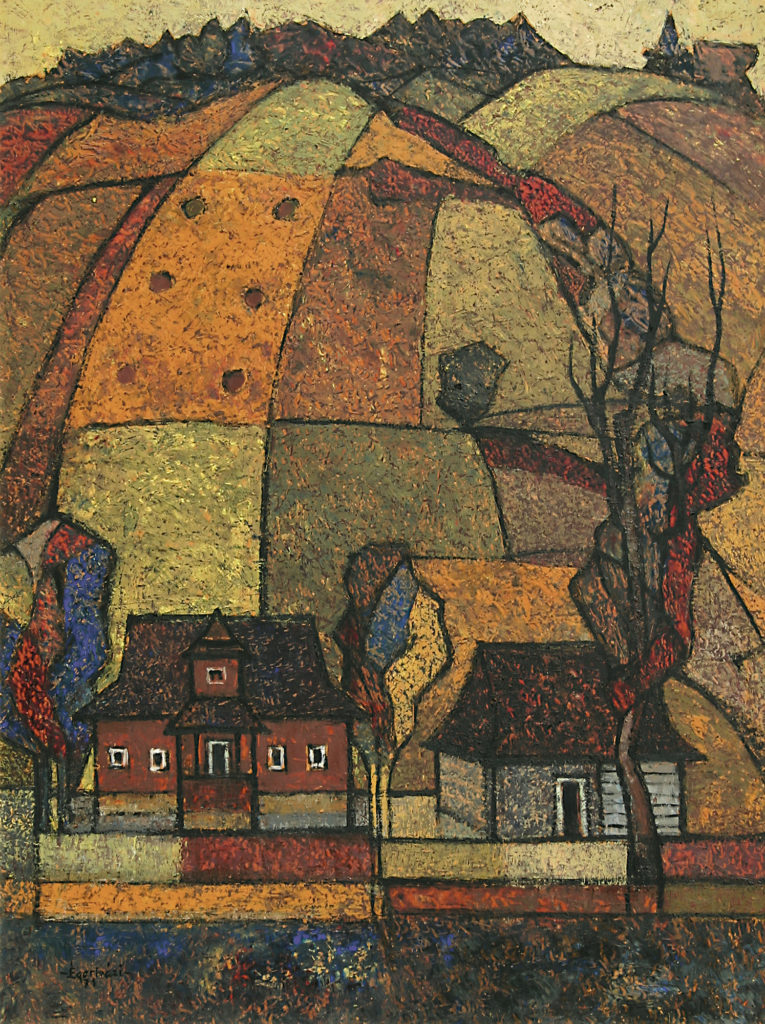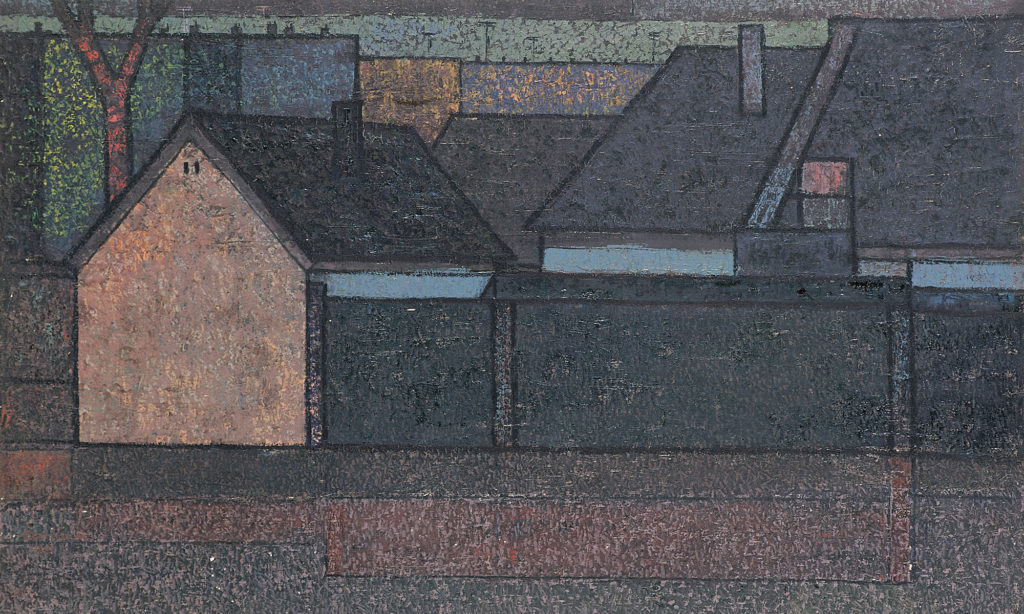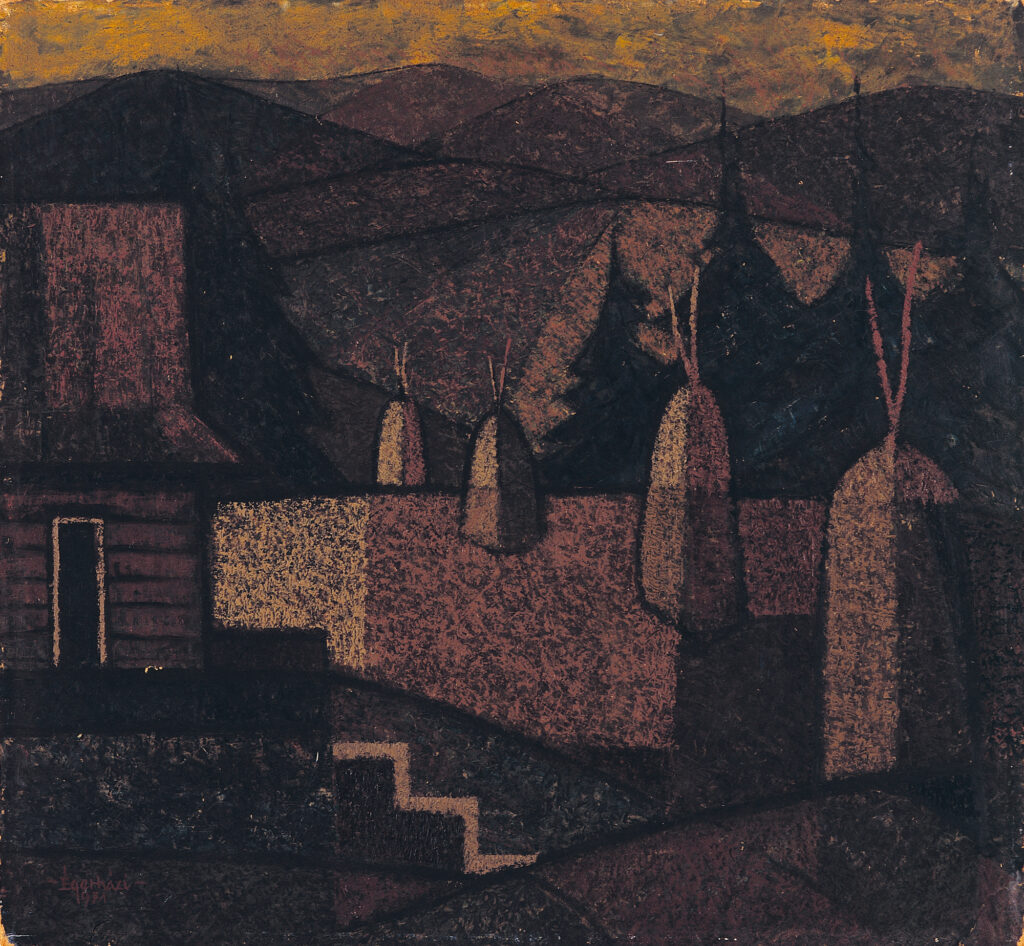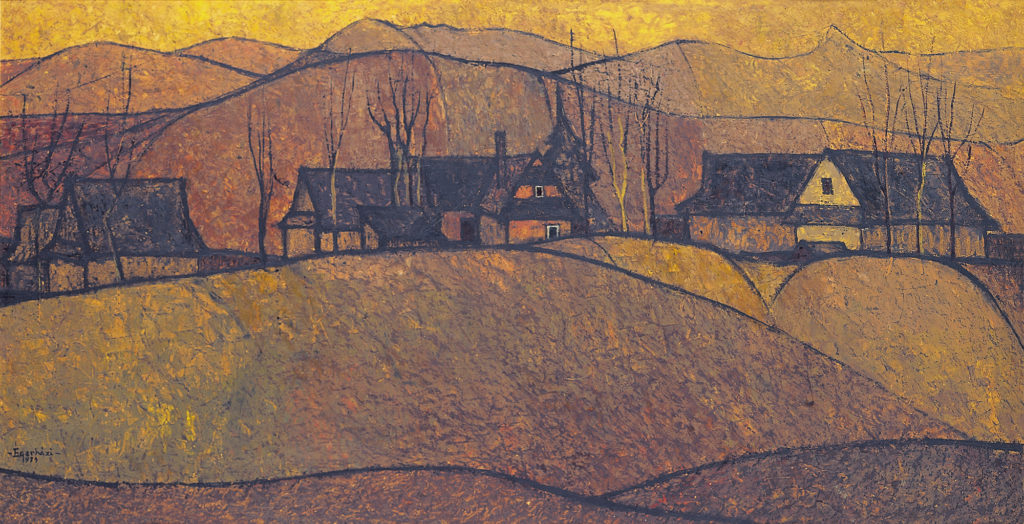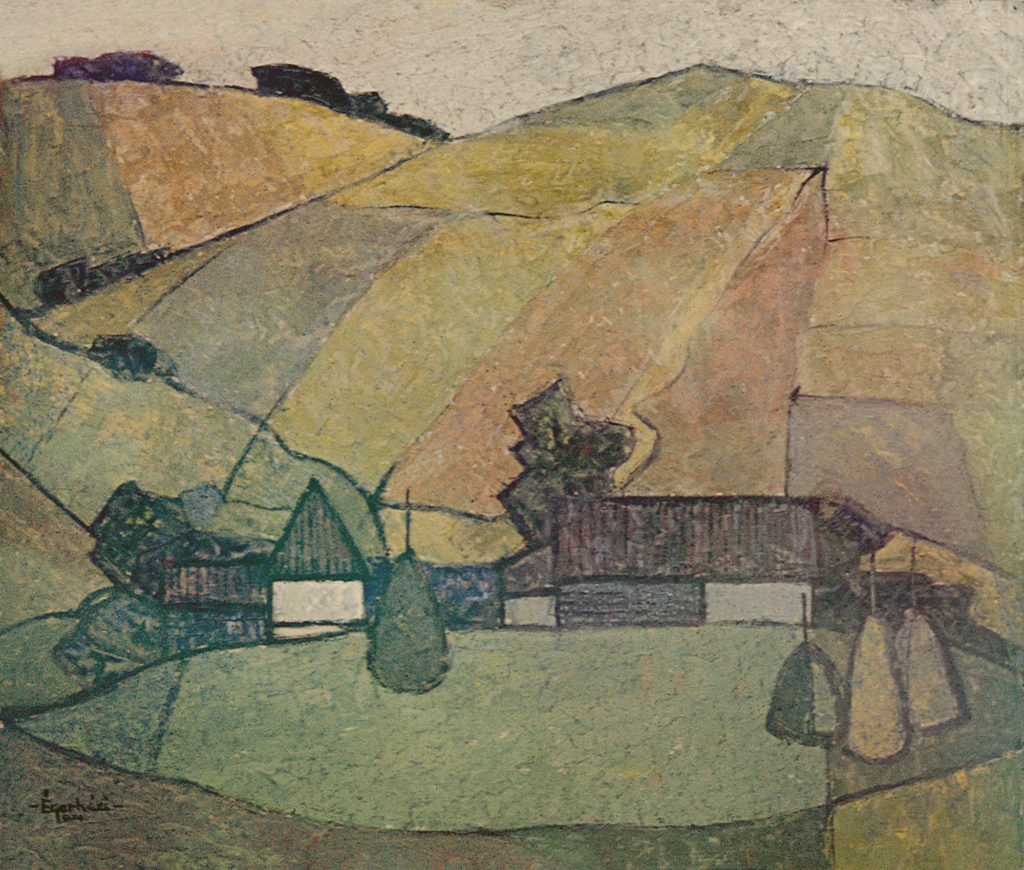The exhibition was opened by Tamás Ervin, Vice-President of the Association of Hungarian Fine and Applied Artists
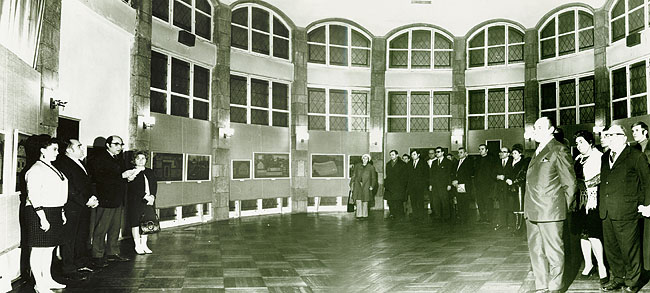
Portions from the opening speech of Ervin Tamás
“…The pictures effect with the concise simplicity of folk songs…
…The pursuit of the essence is the supreme virtue of these works. He avoids any excess in colors and in details, without thereby impoverishing your experience. Selects with a sure sense what can only be said by the painting…
…The balance and structure of the composition, the careful workmanship of the surface (texture), the drawing discipline testify to the presence of the weighing intellect.
The restrained, loud color world expresses a kind of shy emotionality and lyricism. Puritanism is manifested, among other things, in the fact that instead of the illusion of space, or the impressionistic and atmospheric perspective, it composes in a plane – in two dimensions. He doesn’t want to dazzle, but to make a quiet contemplation. This is why he avoids high contrasts. His gloomy colors testify to a mature, self-aware, demanding artist who has matured over a definite period of time. About an artist who always starts from reality and does not imitate it, but adds his own humanity with profound art…
…He expresses the topic with modern tools that you know from within and can therefore honestly identify with. ”
Ervin Tamás
At the opening at the exhibition in Budapest, 1972
Introduction in Budapest
A visit at the painter Imre Égerházi
(Article from Hajdú-Bihari Napló, published on January 23, 1972)
Imre Égerházi has been featured in various exhibitions for about 10 years, and especially in recent years he has received more and more appreciation from professional circles, critics and the public. Now he has reached a significant milestone in his career: the board of the exhibiting institutions is holding his first solo exhibition in Budapest from January 25 to February 7 in the exhibition hall of the MOM House of Culture. The opening will be held by Ervin Tamás, renowned painter and artist educator. Imre Égerházi exhibits oil paintings painted on 33 sheets of wood, most of which process the experiences of his Transylvanian travels.
As soon as I heard about the events on television, I visited the painter at his apartment in Debrecen. He lives with 4 others in a one-and-a-half-room apartment on the 3rd floor. His territory is a 3 x 3 meter room, that doubles as a studio, a storage, and bedroom. It’s a common joke about rooms like this that if one goes in, two have to come out. But his nerves are still good, his freelance is humorous, a little wrapping, re-arranging, and the guest can fit in.
The small icons, wall clocks, folk-themed plates cling scared to the two free walls as if for fear of their place. An almost finished painting awaits the last brushstrokes on the easel. After the conversation, Imre Égerházi will continue to work, as every minute is expensive and there is not enough free time. He is a respected employee of the SZTK, a member of the staff, who conscientiously continues his training in his civilian profession.
– Isn’t this a bit much? – I ask.
“It is.” is the answer. – But I can still handle it. Summer’s end is a hell of a hard time, that is when I come back from the artists ’colony. There, I can work in calm conditions, emotionally and thoughtfully, before the expert eyes of my colleagues. This is when I immerse myself in artistic thoughts, and then I find myself drowning in files again without any transition. This is difficult because the artist is somehow always preparing for his art. It takes a while for me to get used to being an “amphibian” again. I owe a lot to the artists’ colony in Böszörmény, without the creative conditions, professional experience and intellectual influences I received there, I would not be able to imagine my life today.
We turn to the course of the conversation, the words are directed to his pictures and his next exhibition. Although he now presents only paintings, he could not decide which he likes more: painting or graphics. However, whatever technique he works with, the theme of his creations is stubbornly always the same: the landscape, and the man in it.
– I caught on to this topic as a child: people with angular faces, cumbersome movements, hardened by work but still caring and humane. And our land, the deserted, underestimated land of the Great Plain, the houses with human faces, the streets, the landscape details, the animals belonging to people. I paint this, I want to testify with it, cleanly, without magic, with restrained colors, lines, shapes.
“Yet you had more success with your paintings about Transylvania,” I note.
– Yes. I have been returning to Transylvania every summer for years. I am captivated by the grim majesty, barrenness, drama of the countryside, the struggle between man and nature. I will try to show this in my newer pictures. quite a few have asked how long I want to do this. As long as I paint it out of my system, until another great experience extinguishes it inside me. I don’t know what that experience will be, but I’m certain it won’t be a formal consideration. Several people said and described that I follow and revive the traditions of the Hungarian Art Nouveau. Maybe. But it never occurred to me to cultivate Art Nouveau and look for the subject. My style has always been shaped by what I have to say, and will continue to be so. I confess the importance of form and craftsmanship. Make sure the image is in order, and conscious editing prevails. But I don’t believe that art is brought forward by new forms.
We agree on this. And we are confident that Imre Égerházi will be a success among the Budapest audience after several independent and even more collective rural exhibitions.
Imre Égerházi exhibition opened in Budapest
(Article from Hajdú-Bihari Napló, published on January 27, 1972)
The painter Ervin Tamás opened the exhibition of Imre Égerházi, who lives and works in Debrecen, at the MOM Szakasits Árpád Cultural House in Budapest on January 25 at four o’clock in the afternoon. The opening words emphasized the exhibiting artist’s connection to the landscape and the natural directness of his works.
The pictures effect with the concise simplicity of folk songs. This is evidenced by not only their choice of theme but also their content and shape. The pursuit of the essence is the supreme virtue of these works. He avoids any excess in colors and in details, without thereby impoverishing your experience. The balance and structure of the composition, the careful workmanship of the surface, the drawing discipline testify to the presence of the weighing intellect.
Said Ervin Tamás about the paintings inspired by the landscape of Hajdúság and the paintings about Transylvanian experiences, which make up about two-thirds of the material on display. The exhibition of Imre Égerházi, featuring thirty-five oil paintings, can be visited by those interested until February 7.
The exhibition of Imre Égerházi in Budapest
(Article from Közalkalmazott by Mária Sarkady, published on March 8, 1972)
The first exhibition of the painter Imre Égerházi in Budapest opened on January 25 in the exhibition hall of the MOM Árpád Szakasits Cultural House.
This exhibition is also memorable because it showcased the work of an artist who had a so-called “harder journey” in his artistic career, because in the years when most of his colleagues could go to college, he already had to work. And in addition to his work as an artist, he still works as a civil servant and is the group leader in the Pension Department of the Debrecen Social Insurance Directorate.
– How long have you been drawing?
– Since I was a little kid. When my father worked in a printing press, he brought home pieces of coal and paper several times, and it was my first year in primary when I somehow got a package of crayons as a gift from the Swiss Red Cross. At the time I didn’t know what it was, it was just great to draw with on the walls of houses and gray fences.
– And you started again besides having a job?
– Yes. My master was painter József Menyhárt. And here I can also say that in 25 years in Debrecen, only János Kapcsa and I managed to get to the artistic level from the study group movement.
– Since when you exhibit?
– I started in 1957-58, but then only within certain limits. I was not able to attend many exhibitions and was also excluded from state purchases.
– And when did these limitations perish?
– More than 10 years ago, when I became a member of the Arts Foundation and the Association of Fine Artists. This exhibition in Budapest is an important stage in my life. And I am particularly pleased that it was held here. I prefer to exhibit at an institution that is not attended by the usual exhibition audience.
– But will they appreciate you?
– I find that an exhibition should have educational value. Take an example from Debrecen: there is the Medgyessy Hall and three or four cultural houses. I am more than happy to see my paintings not in the middle of the city but in the Csapó Garden. As a union cultural, for 15 years I have been striving to make the various arts loved by masses who have not been given such a start in their own homes.
– Do you have a studio?
– I don’t. I work in one of our rooms. I can’t paint larger boards there.
– How much free time you got?
– I have the standard 24 days leave, 6 to 8 days bonus, all other goes unpaid.
– It was said in the opening speech that your painting starts from reality, but does not imitate it. For example, how much the Gheorgheni landscape IV. looks like the real thing?
– Exactly. Look, I make such a thorough site plan, and from that I work on a degree of abstraction I find acceptable.
– And Serfs in the outskirts?
– I saw them in the market in Böszörmény. The old woman too. I told her, “Dear woman, would you have an hour for me to draw you?” She said, “I’ll come, my dear, and tomorrow if I have to.”
– Could the union be any help for you?
– It would be great to have the opportunity to participate in a joint national exhibition with artists who have reached a similar artistic level.
Introduction in Budapest
A visit at the painter Imre Égerházi
(Article from Hajdú-Bihari Napló, published on January 23, 1972)
Imre Égerházi has been featured in various exhibitions for about 10 years, and especially in recent years he has received more and more appreciation from professional circles, critics and the public. Now he has reached a significant milestone in his career: the board of the exhibiting institutions is holding his first solo exhibition in Budapest from January 25 to February 7 in the exhibition hall of the MOM House of Culture. The opening will be held by Ervin Tamás, renowned painter and artist educator. Imre Égerházi exhibits oil paintings painted on 33 fibreboards, most of which process the experiences of his Transylvanian travels.
As soon as I heard about the events on television, I visited the painter at his apartment in Debrecen. He lives with 5 others in a one-and-a-half-room apartment on the 3rd floor. His territory is a 3 x 3 meter room, that doubles as a studio, a storage, and bedroom. It’s a common joke about rooms like this that if one goes in, two have to come out. But his nerves are still good, his freelance is humorous, a little wrapping, re-arranging, and the guest can fit in.
The small icons, wall clocks, folk-themed plates cling scared to the two free walls as if for fear of their place. An almost finished painting awaits the last brushstrokes on the easel. After the conversation, Imre Égerházi will continue to work, as every minute is expensive and there is not enough free time. He is a respected employee of the SZTK, a member of the staff, who conscientiously continues his training in his civilian profession.
– Isn’t this a bit much? – I ask.
“It is.” is the answer. – But I can still handle it. Summer’s end is a hell of a hard time, that is when I come back from the artists ’colony. There, I can work in calm conditions, emotionally and thoughtfully, before the expert eyes of my colleagues. This is when I immerse myself in artistic thoughts, and then I find myself drowning in files again without any transition. This is difficult because the artist is somehow always preparing for his art. It takes a while for me to get used to being an “amphibian” again. I owe a lot to the artists’ colony in Böszörmény, without the creative conditions, professional experience and intellectual influences I received there, I would not be able to imagine my life today.
We turn to the course of the conversation, the words are directed to his pictures and his next exhibition. Although he now presents only paintings, he could not decide which he likes more: painting or graphics. However, whatever technique he works with, the theme of his creations is stubbornly always the same: the landscape, and the man in it.
– I caught on to this topic as a child: people with angular faces, cumbersome movements, hardened by work but still caring and humane. And our land, the deserted, underestimated land of the Great Plain, the houses with human faces, the streets, the landscape details, the animals belonging to people. I paint this, I want to testify with it, cleanly, without magic, with restrained colors, lines, shapes.
“Yet you had more success with your paintings about Transylvania,” I note.
– Yes. I have been returning to Transylvania every summer for years. I am captivated by the grim majesty, barrenness, drama of the countryside, the struggle between man and nature. I will try to show this in my newer pictures, quite a few have asked how long I want to do this. As long as I paint it out of my system, until another great experience extinguishes it inside me. I don’t know what that experience will be, but I’m certain it won’t be a formal consideration. Several people said and described that I follow and revive the traditions of the Hungarian Art Nouveau. Maybe. But it never occurred to me to cultivate Art Nouveau and look for the subject. My style has always been shaped by what I have to say, and will continue to be so. I confess the importance of form and craftsmanship. Make sure the image is in order, and conscious editing prevails. But I don’t believe that art is brought forward by new forms.
We agree on this. And we are confident that Imre Égerházi will be a success among the Budapest audience after several independent and even more collective rural exhibitions.
Exhibition of Imre Égerházi in Budapest
(Article from Alföld by Rezső Szíj, published in February 1972)
There seems to be some truth in the fact that ancient heritage can be traced back centuries. The inclination and talent for an artistic craft, like an underground river, rises to the top and is reborn in the offspring. One of the ancestors of Imre Égerházi, as he painted the court council room and the walls and ceiling of the Alvinc castle in Gyulafehérvár to his satisfaction, was raised to nobility by the Transylvanian prince György I.Rákóczi, and received the forename “Képíró”. But in Imre Égerházi, who was born in the Great Plain, not only the tendency towards painting was reborn, but also his attraction to the Transylvanian landscapes. The consequence of this is that he goes to the Székely and Csángó villages on both sides of the Carpathians almost every year, and that he draws the motifs of his paintings largely from this region. And we can even name a third determining factor, but this refers in part to a source closer to us in time. For those artists who, in their works, saw the Transylvanian mountain landscapes, hillsides, villages, pastures, cottages in a somewhat similar way, but also the land of Hajdúság, its houses, homesteads and people with a lot of sympathy.
Imre Égerházi was born in 1925 in Hajdúhadház. His skills were already present in primary school: he drew on all surfaces, like benches, house walls, calendars, and everything that caught his eye, people and animals alike. Later, in addition to his talent, he acquired all the craftsmanship that is essential as a prerequisite for a work of art. Since 1962, he has been a regular participant in group exhibitions in Hajdúság.
He organized three solo exhibitions in Debrecen (1963, 1966, 1969), and now in January his solo exhibition opened in Budapest at the MOM House of Culture. He regularly participates in the Great Plain Exhibitions in Békéscsaba, the Szeged and Balaton Summer Exhibitions.
The material on display again conveyed the message of Hajdúság and Székelyföld. Landscapes of Gyergyó and Gyimes, village details with houses, buffaloes, grazing horses, mountain pastures, wooded hillsides, wooden houses in the village, carved gates (Gyergyó hillside, Gyergyóremete, Gyimes landscape). The picture changes when the landscapes of Hajdúság come out from under his brush: we meet typical homesteads, people with bony faces in Hajdúság, cemeteries with an elegant atmosphere (Hajdúböszörményi házak, Böszörményi utcán, Hajdúsági emberek a határban). This is the world that welcomes the spectator at Égerházi’s exhibition, and as far as formal representation is concerned, it is revealed during the formulation of the individual features of art that this art is organically connected to the line of Transylvanian art, which is represented by drawing elements and line characterized. It is related to the art close to the people, which is characterized not by the presence of appearances and ornaments, but by the line vision that characterizes the art of Károly Kós for example, and the period of the Hungarian Art Nouveau marked by Károly Kós in general, and the high-level artistic representation won by the representatives of Hungarian architecture and art history in these years, also honored in monographs. Égerházi also thinks and sees in the line and spot characteristic of the new Art Nouveau. He separates parts of the image with sharp contours, delimits objects and image fields and do not entrust to separate colors. The alleged color poverty of neither the Great Plain nor the mountainous landscape provides a sufficient explanation for why he uses relatively few colors. Perhaps it can be explained more by psychological reasons. Whoever doesn’t find much consolation in life, who sympathizes with the tired, broken man, who loves the cemetery even at a young age, the symbol of passing away (Hajdúsági temető), his spiritual world woven from serious colors and the resulting worldview with less vivid, more gloomy colors project it into your pictures. It is not as if the world of Égerházi is particularly depressing, but rather that of the mountain man, who is trapped in the gorges of the mountains, rarely and even for a short time. And he has become accustomed to this in such a way that the plains of the Great Plain do not reveal their colors.
From the fact that the image fields are spread widely next to each other and separated by lines, we have to deduce a geometric editing method. He even displays the human face with strict geometry, without pushing it towards unrecognizability. Conversely: Égerházi clearly articulates, avoids obscurity, abstraction. And it also follows that his paintings exude serenity, order, discipline, in which everything has a place, as in a life that does not allow derailment, because he has to prove his right to live every day and he cannot risk it with ill-considered steps.
Looking more closely at his images, it turns out that what seems like a fancy depicted from a single color from afar, with how subtle tonal differences he is meticulously nuanced.
By placing the buildings next to each other and on top of each other, by emphasizing the architectural elements, he reveals a conceptual kinship – no matter how surprising this finding may seem, he is connected to one of the wings of the school of the Great Plain through his large-horizon and horizontally edited Great Plain paintings.
Égerházi visibly likes the landscape, but some stills also deserve attention. The picturesque perception of this is the same as in his landscapes: it borders the surface divided by colors with contours. He divides Madaras Csöndélet into four fields, as proof that he not only feels the structure instinctively, but also consciously shapes it.
He rarely uses an ethnographic object in his paintings, there he does not emphasize it, but integrates it organically into the whole image (Kulacsos csöndélet, Sárga virágok széken).
We met a material with a unified approach and an artist with a definite image at Imre Égerházi’s exhibition in Budapest. If this unity and determination expressed in the works becomes bolder in color in the coming years, we can witness a new era in the art of Imre Égerházi.
Exhibition of Imre Égerházi in the MOM House of Culture
(Article from Munka by Dr. Ervin Tóth, published in March 1972)
In the first presentation of Imre Égerházi in the capital, we can look at the works of a painter who, with a fanatical attraction to painting, undertook to worship the great passion of his life in his free hours and summer holidays. In recent years, the esteemed employee of the Social Welfare Board has played an increasingly important role in the fine arts life of Debrecen, his drawings and pictures are increasingly published in our leading newspapers and magazines, he is a regular exhibitor of autumn and spring exhibitions, Miskolc biennials, domestic and foreign collectives. But until he got here, he had to fight with extraordinary willpower for every line and every brushstroke. His father was an agricultural laborer and then a printing press worker, and in the past he obviously could not allocate funds to raise his son for the arts. Though the child won several drawing competitions, he still had to go to manual labor. He was a factory heater, loader, agricultural worker, lumberjack, construction worker, and then office clerk. But his talent still paved the way and today he is at the forefront of art in Debrecen.
In the paintings of Égerházi, he gives a significant place to the landscape of the Great Plain, to the people living in it, but among the pieces of the exhibition, in paintings painted on 33 fibreboards, we can find the experiences of its regularly recurring Transylvanian trips, Gyimes and Gyergyó. But also the part that captures the immediate homeland, the romantic beauties of Hajdúság. Most of these works were made at the Böszörmény artists’ colony, of which he is a founding member.
What characterizes his painting? The strong structuralism he has relaxed to some degree in recent years to the advantage of his art. Even if it splits the space of his images, the unit is unchanged, and each graphically delimited area is processed with extremely fine guarding and sensitive gradients. He likes to tune his colors deep, especially in his Transylvanian paintings, revealing the nexus of the land and the people and animals living there, their common destiny. His picturesque figure is extremely multi-toned, he considers the spectacle with disciplined care, without diminishing the emotional mood of his paintings.
From manual laborer to artist
(Article from Népművelés, published on March 5, 1972)
The exhibition of Imre Égerházi (from Debrecen) opened in January at the MOM Cultural House. The career of Imre Égerházi (born in Hajdúhadház in 1925) is a good example of how working in another money-making career can lead to the high artistic level experienced at the exhibition – with extraordinary willpower.
In his free time he paints and sketches at the artists’ colony in Hajdúböszörmény and on his trips to Transylvania; on wood plates he matures them into large oil paintings. His works now on display include not only the environment of Gyergyó and the landscape of Gyimes, but also experiences related to his immediate homeland, Hajdúság.
Among his paintings, we highlight the typically Székelyföld-esqe Women of the land of Gyergyó. Although we do not encounter graphics among his current works, the structure of his paintings, their geometric structure, the intertwining of lines, and the finely crafted transitions of colours indicate that graphics also play a significant role in Égerházi’s oeuvre so far. His oil paintings are mainly landscapes and street details, but we also encounter stills, houses and square-faced workers among his works.
About Imre Égerházi’s exhibition in Budapest
(Article from Hajdú-Bihari Napló by Ervin Tóth, published on February 2,1972)
Imre Égerházi exhibited oil paintings painted on 33 fibrebards from the material of the last 3-4 years, with a variety of themes and a uniform tone, in the dome hall of MOM. Those who have been monitoring his development for a time could find that his subject matter is wider and broader, reaches out more to the figural representations, his strict constructiveness has loosened, the surface treatment of the images has become more demanding and rich in tone.
Reviewing the material of the exhibition, we can divide his works into three groups: the serious landscapes of Gyimes, the environment of Gyergyó, already articulated in warmer colors, and finally the world of his immediate home, Hajdúság. Some of the paintings were made at the artists’ colony in Böszörmény, but many of the sketches and plans were matured into large oil paintings in the artists’ house of the Debrecen artists’ colony. We can highlight from his oeuvre the characteristic Székelyföld-esqe Women of the land of Gyergyó; the Gyímes landscape, which illuminates the struggle with the land, the life connected to it, the struggle with nature; the greenish-yellow tone Horses; the warm-soft Gyergyó landscape I.; and the direct simplicity of Flower still with bird featured on the cover of the catalog; the Autumn Sunshine interwoven with red shades, which still has a monumental effect despite its small size, prevailed in full in the well-lit MOM room.
Imre Égerházi returns to Transylvania almost every summer. The restrained color scale of his paintings is shaped according to the attraction and atmosphere of the landscape and becomes clear in its overall effect, or an instrument with a dark tendency that suggests tragedy. He can achieve all this with simple tools, avoiding any excess in details and colours. Ervin Tamás, who opened the exhibition, also pointed out the balance of Égerházi’s image structures, the careful workmanship of the surface and his drawing discipline. All of these are not only the most striking features of the art of Égerházi, but also the features that ensure the further curving of his picturesque journey.
Although graphics play a significant role in Égerházi’s oeuvre (mainly the monotype), the exhibition lined up only oil paintings, but the geometric structure and spatial divisions of the pictures also emphasized the role of the line. These landscapes, parts of the streets, stills (with pots and flowers) are in harmony with this style, with houses indicating the presence of man, or with square-faced, tired people, animals (horses, buffaloes) as part of that life inseparably , where he gave only a minor role to the space-dissolving effect of air. In the first debut of the Debrecen painter in the capital, we must not forget that it is the work of an artist who, in addition to his demanding office work, committed himself to devoting all his free time to the great passion of his life. And this fanaticism, in some inexplicable form, lives there in the fabric of his paintings and radiates back to the spectator.
Letter from the Cultural Committee
Respected comrade!
We would like to inform you that the exhibition of the painter Imre Égerházi, an employee of the Social Insurance Directorate of Debrecen, will commence in
the MOM House of Culture
from January 25 to februar 7, 1972.
Imre Égerházi is one of the aspiring artists who sticks to their goals in all circumstances. His living conditions did not allow him to live only for painting, yet it became the center of his life. His exhibition material consists exclusively of oil paintings, but he works in almost every branch of graphics. He constructs his figural images constructively, and is closely connected to a specific theme or phenomenon. He especially loves the Transylvanian landscape, which he visits every year. He carefully stores his experiences of Székelyföld and then processes them at home based on his sketches with the help of abstraction accepted for himself. His colour scheme works in a definite, deep tone, as he loves dark contours. This is about determining the power of his forms, and at the same time his adherence to the purity of the line and the drawing. His image material is uniform in both content and form, and consistently follows the goals he has set. He also elaborates his images carefully on the surface. He loves them, lives with them and breathes with them. His relationship with nature and man is extremely intense. He immerses himself in the beauties and atmosphere of the landscape. His passionate attraction to Székelyföld inspired his best paintings. What he has to say is a sincere manifestation of a man through the eternal language of painting.
Budapest, 23-01-1972
Cultural Committee
Magyar Rádióban (Kossuth adó) 1972. január 25-én este 7 órakor,
Esti Krónikában elhangzott tudósítás
(Szathmári Ilona írásában)
Hajdúhadház szülötte, a Hajdúsági Művésztelep alapító tagja Égerházi Imre festőművész remek, szép olajfestményei közül harminchármat mutat be a Magyar Optikai Művek Művelődési Házának kupola termében. A Debrecenben élő művész első, önálló budapesti kiállításán egy csokorra valót állít elénk mély tónusú, ihletett szépségű tájképeiből.
Égerházi mester különösen kedveli az erdélyi, a székelyföldi tájat, ahová minden évben ellátogat. Ez a különös, szenvedélyes vonzalma a székelyföld iránt inspirálták legjobb képeit.
Azok közé a festőművészek közé tartozik, akik teljesen beleélik magukat a természet, az évszakok, a táj szépségeibe, hangulatába.
Csángó és gyergyói festményein kívül Égerházi Imre tárlatán megejtő szépségű virágcsendéletek, nagyalföldi tájak is gyönyörködtetnek bennünket.
Égerházi Imre tárlata január 25-től február 7-ig tekinthető meg.



